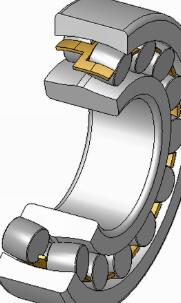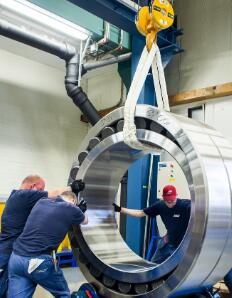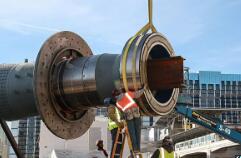The Advantages of Spherical Roller Bearings in Industrial Applications
Discover the benefits of using spherical roller bearings in industrial applications.
Find out how spherical roller bearings can benefit your next industrial application.
Spherical roller bearings offer a range of advantages for industrial applications, making them a popular choice for many machines.
This article explores the advantages of using spherical roller bearings, such as their ability to tolerate misalignment, provide higher load-carrying capacity and shock absorption, and offer longer service life.
Spherical roller bearings have a higher load capacity and longer life than other bearing types, and they are self-aligning to accommodate misalignment.
These bearings are also very resistant to shock loads, making them suitable for applications that experience large variations in load or speed.
Know more about the advantages of spherical roller bearings and the specific applications in the industries that are benefited from using one.
Learn how to properly install these bearings and understand their maintenance requirements of it.
What are Spherical roller bearings?

Spherical roller bearings are roller bearings with a spherical outer ring.
They are an important type of bearing used in many applications where the inner and outer raceways incline to each other.
The inner ring has two raceways and the outer ring has a single spherical raceway.
This design allows the bearing to have a self-aligning capability and can accommodate misalignment of the shaft relative to the housing.
These bearings are also able to accommodate heavy axial loads, high speeds, and shock loads.
They are typically used in applications such as gearboxes, conveyors, machine tools, and pumps.
They are also widely used in the automotive industry for wheel hub bearings, driveline components, and other applications.
Advantages of Spherical Roller Bearings

Increased load capacity compared to other bearing types.
Spherical roller bearings have a higher basic load rating than other bearing types due to their increased load capacity.
This increased load capacity is due to their improved internal geometry, which allows them to have more contact with the bearing raceway.
This increased contact provides more surface area to distribute the load, resulting in higher load capacity.
Additionally, the increased number of rolling elements in these bearings also helps to spread the load more evenly, which further increases their load capacity.
The combination of these two features means that spherical roller bearings can handle higher load capacities than other bearing types, making them suitable for high-load applications.
Ability to accommodate misalignment, reducing the need for precise alignment.
Spherical roller bearings are designed to accommodate misalignment, allowing them to be mounted in applications where the shafts may twist or move relative to one another
. The rollers of the bearing are specifically designed to accommodate misalignment, allowing them to roll freely in the bearing even if the shafts are not perfectly aligned.
This reduces the need for precise alignment during installation and allows the bearing to operate in situations where the shafts move or bend relative to one another.
The bearing's ability to accommodate misalignment also makes it a great choice for applications where shafts run at high speeds or experience heavy loads.
Durability and longevity due to robust design and materials.
Spherical roller bearings are renowned for their durability and longevity due to their robust design and materials.
The inner and outer rings of the bearing are made from high-quality steel that has been heat-treated for maximum strength and rigidity,
while the rollers themselves are made from hardened steel and feature a special surface finish that helps reduce friction and wear.
The rollers are also designed to be self-aligning, which helps to reduce the amount of stress on the bearing and increases its lifespan.
Additionally, the bearing is also equipped with a special lubrication system that helps to extend its life even further.
Reduced maintenance and downtime due to fewer bearing replacements.
Spherical roller bearings feature an improved design that reduces the need for regular maintenance and bearing replacements.
The improved design of these bearings minimizes the potential for bearing-related downtime, reducing the need to replace bearings more often.
Spherical roller bearings have a high load capacity, which extends their lifespan and reduces the need for frequent maintenance.
They feature an improved lubrication system that reduces heat and friction, extending the life of the bearing and reducing the need for frequent bearing replacements.
Reduced noise and vibration compared to other bearing types.
Spherical roller bearings have the advantage of reduced noise and vibration compared to other bearing types because the rollers are designed to have a large contact area,
which helps to spread the load and reduce vibration.
Additionally, their construction eliminates the need for any contact between the inner and outer races,
which further reduces noise and vibration. The spherical shape of the rollers also helps to reduce the contact between the rollers and the races, which further reduces noise and vibration.
Finally, the rollers are designed to have a larger diameter, which helps to reduce the frequency of the vibrations and noise.
Applications of Spherical Roller Bearings in Industry

Examples of industries that benefit from the use of spherical roller bearings, such as mining, construction, and wind energy.
1.Mining: spherical roller bearings are used to support the heavy loads required for mining operations, as well as reduce vibration and noise.
2.Construction: spherical roller bearings are used in many construction types of machinery,
such as cranes, excavators, and bulldozers, to ensure proper operation.
3.Wind Energy: spherical roller bearings are used to support the rotating shafts of wind turbines and provide a reliable,
low-maintenance solution for the harsh conditions of wind energy production.
4.Agriculture: spherical roller bearings are used in tractors, combines,
and other agricultural machinery to support the load of the machinery and ensure smooth operation.
5.Automotive: spherical roller bearings are used in a variety of automotive applications to support loads and reduce vibration and noise.
Explanation of specific applications, such as conveyor systems, crushers, and gearboxes.
Spherical roller bearings are typically used in conveyor systems, crushers, and gearboxes because they can withstand heavy loads at high speeds.
Conveyor systems require bearings that can support the weight of the materials being transported while also providing smooth motion.
Spherical roller bearings are great for this application because they have a high load capacity and can operate at high speeds.
Crushers also require high-load capacity bearings that can withstand the large forces generated when materials are crushed.
Spherical roller bearings are great for this application because they can withstand the high radial and axial loads generated by the crushing process.
Gearboxes require bearings that can operate at high speeds and provide smooth rotation.
Spherical roller bearings are great for this application because they can withstand high radial and axial loads, which is important when transferring high levels of torque from the motor to the driven shaft.
Additionally, they can operate at high speeds, which is necessary for high-speed applications.
Proper Installation and Maintenance of Spherical Roller Bearings
Importance of proper installation, including proper lubrication and alignment.
Spherical roller bearings are essential components in many industrial machines and processes, so proper installation is essential for the safety, efficiency, and longevity of the machinery.
Proper lubrication and alignment ensure that the bearings are correctly seated, with the correct amount of lubricant, and that the bearing races are in perfect alignment.
This prevents the bearing from prematurely wearing out, reduces friction, and increases the bearing’s efficiency.
The incorrect installation often results in premature bearing failure, which can cause expensive downtime and costly repairs.
Proper installation also helps to reduce noise, vibration, and temperature, making sure that the bearing is running at its most efficient.
In addition, proper installation is essential for the safety of the machinery, personnel, and environment.
It is important to ensure that the bearings are correctly installed and that the lubrication and alignment are correct to prevent any accidents or environmental damage.
Overall, proper installation of spherical roller bearings is essential for the safety, efficiency, and longevity of machinery.
It is important to follow the manufacturer’s instructions and use the correct tools and lubrication to make sure that the bearings are correctly installed, lubricated, and aligned.
Explanation of maintenance requirements, including inspection, lubrication, and replacement schedules.
The maintenance requirements of spherical roller bearings depend on the application and operating environment.
Generally, it is recommended that spherical roller bearings be inspected regularly and lubricated as needed.
Inspection: Spherical roller bearings should be inspected to detect any signs of damage or wear.
The inspection should include a visual check to determine if there are any cracks, dents, or other signs of damage.
Additionally, the bearing should be checked to make sure that it is properly mounted and aligned.
The bearing should also be checked for any signs of corrosion or other contamination.
Lubrication: Spherical roller bearings should be lubricated according to the manufacturer’s recommendations.
Depending on the application and operating environment, the bearing may need to be lubricated with oil, grease, or a combination of both.
The lubricant should be applied to the bearing races, rollers, and seals.
Replacement: Spherical roller bearings should be replaced when they have reached the end of their service life.
The service life of a spherical roller bearing is determined by the application and operating environment.
Generally, spherical roller bearings should be replaced if they have become noisy, if they have abnormally high vibration levels, or if they have excessive wear.
Conclusion
Spherical roller bearings offer some advantages for industrial applications, including reduced friction, increased bearing life, and improved performance. These advantages make them an ideal choice for many applications and help to ensure optimal performance and reliability.





